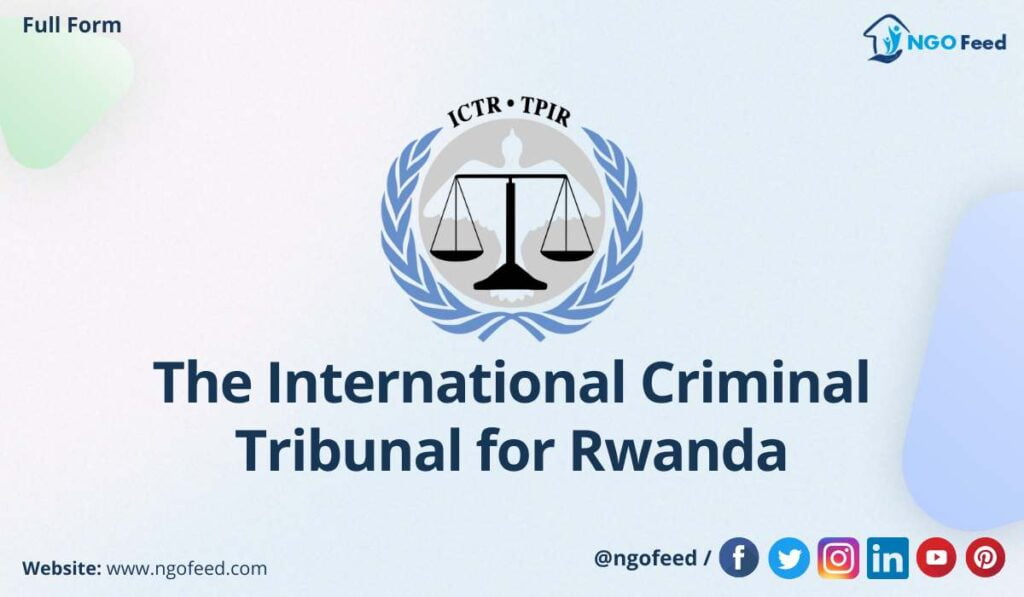ICTR Full Form: To “prosecute persons responsible for genocide and other serious violations of international humanitarian law committed in the territory of Rwanda and neighbouring States, between 1 January 1994 and 31 December 1994,” the United Nations Security Council established the International Criminal Tribunal for Rwanda (ICTR). The Tribunal maintains offices in Kigali, Rwanda, and Arusha, Tanzania. The Hague, Netherlands, is home to the court’s appeals chamber.
The Tribunal, which was established in 1995, has charged 93 people with grave violations of international humanitarian law that were perpetrated in Rwanda in 1994. High senior military and government officials, legislators, businessmen, and leaders in the media, militia, and religion are among those charged.
Table of Contents
ICTR Overview
This section briefly overviews ICTR (International Criminal Tribunal for Rwanda.). Let’s have a look.
| ICTR | International Criminal Tribunal for Rwanda. |
| Headquarters | Arusha, Tanzania |
| Formation | 8 November 1994 |
| Authorized by | United Nations Security Council Resolution 955 |
| Number of positions | 16 permanent 9 ad litem |
| Website | https://www.unictr.org/ |
History
The term “genocide” refers to the systematic killing of more than 800,000 members of the ethnic Tutsi and politically moderate Hutu in Rwanda under the command of government-sponsored bands of Hutu extremist military and police. The genocide of 1994 is typically referred to as lasting 100 days, starting on April 6 and finishing in the middle of July.
Because of German and Belgian rule over Rwanda, the conflict between the majority Hutu and the minority Tutsi had long existed. Still, it was notably accentuated in the late nineteenth and early twentieth centuries. The two were arbitrarily categorised as belonging to different ethnic groups based more on physical traits than ethnic heritage. The Tutsi, who have a strong pastoralist legacy, have traditionally gained social, economic, and political superiority over the Hutu, largely agriculturalists, due to the societal distinctions between the Hutu and the Tusi. Tutsis maintained their rule because of the distinction under colonial powers until a Hutu revolution in 1959 ended the Tutsi monarchy by 1961.
As “new rounds of ethnic tension and violence flared frequently and resulted in mass deaths of Tutsi in Rwanda, such as in 1963, 1967, and 1973,” the animosity between the two groups persisted. Ethnic animosity grew after the Rwandan Patriotic Front (RPF) was founded and invaded Uganda. Negotiations between the government and the RPF began in 1992 after these hostilities were put on hold.
On April 6, 1994, a jet carrying Cyprien Ntaryamira of Burundi and the country’s then-president Juvenal Habyarimana was shot down, killing everyone on board. After holding the RPF accountable, the Hutu started a genocide against both moderate Hutus and Tutsis.
The Interahamwe and the Impuzamugambi, two hardline Hutu factions, were responsible for the majority of the slaughter during the genocide in Rwanda. Radio broadcasts were a crucial component of the genocide as they incited Hutu residents to murder their Tutsi neighbours, who were referred to as cockroaches that needed to be eradicated. The genocide was almost entirely carried out by hand, usually with machetes and clubs, despite its enormous scope, especially given how quickly it occurred. Several atrocities were performed, such as the rape of numerous thousands of Tutsi women and the fragmentation and deformity of victims. In many cases, the murderers were people the victims knew personally, including neighbours, coworkers, previous friends, and perhaps even relatives through marriage.
Role of ICTR
There are different ICTR roles, such as:
- The International Criminal Tribunal for Rwanda (ICTR) has been a trailblazer in the development of an effective international criminal justice system, producing a significant body of case law on genocide, crimes against humanity, war crimes, as well as other types of individual and collective responsibility.
- The ICTR is the first international court to rule on genocide cases and the first to interpret the 1948 Geneva Convention’s definition of crime.
- To recognise rape as a method of committing genocide and to define rape in international criminal law.
- It holds media professionals accountable for broadcasts that aim to inspire the general population to commit acts of genocide.
- The ICTR will carry out its mandate to provide justice for the Genocide victims and, in doing so, aims to discourage others from perpetrating the same atrocities in the future.
The tribunal consisted of 16 judges and had three “chambers” for hearing trials and one for appeals. There were a total of 25 judges, including nine ad litem judges. All nine ad litem judges provided their services to Chambers II and III. The pool of nine additional ad literal judges would be called upon in the event of a judge’s absence.
Frequently Asked Questions (FAQs)
What is the Full form of ICTR?
The full form of ICTR is the International Criminal Tribunal for Rwanda.
Where is ICTR located?
ICTR is located in Arusha, Tanzania.
When ICTR is formed?
It is formed on 8 November 1994.
What is the goal of ICTR?
The goal is to “Prosecute those guilty for genocide and other severe breaches of international humanitarian law committed on the territory of Rwanda and adjacent States between 1 January 1994 and 31 December 1994.”

